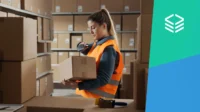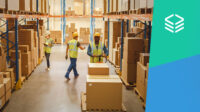It’s clear to anyone with purchasing power that ecommerce is the future of retail. We’ve all seen the statistics: Ecommerce sales are projected to grow to $933.30 billion in 2021, up 17.9% from last year.
A contributing driver of this growth are third-party marketplaces – in particular Amazon, which sees between 5 million and 10 million third-party merchants selling products through its marketplace, accounting for 56 percent of the total items sold on the platform.
Roughly 57 percent of these sellers exclusively use FBA for order fulfillment, per Jungle Scout. With FBA, brands pay Amazon an extra fee to manage their logistical operations – including storage and fulfillment. Sellers using FBA get preferential search and ad placement, and customers buying from them are eligible for two-day Prime shipping.
FBA restrictions and limitations
FBA sellers are also subject to the numerous limitations of the FBA service, including restricted shipments (remember the early days of the pandemic, when only essential items were accepted?), inventory caps, capacity constraints, and a refusal of meltable products from April through October.
To remain eligible for the service, FBA sellers must maintain high levels of inventory; therefore, more cash flow is needed to sustain the business’s success and growth. This can be a significant roadblock for new and even established businesses.
Further, Amazon retains a brand’s customer data – an element critical to strategic planning, customer retention, and ultimately, brand expansion. Branding restrictions and inventory lag time are also drawbacks of relying solely on FBA. Despite this lack of control, brands pay a premium for the service.
The next disruption
FBA restrictions can severely limit the ability of brands to scale, and will put them in a crunch when the next disruption occurs – because it’s not a question of if the next interference will happen, but when and how can brands be better prepared. Concerns like these outline the growing need for FBA alternatives.
Be it a pandemic, a ship stuck in the Suez Canal, or another, yet unknown event or occurrence, brands need a fulfillment contingency plan in place that allows them to keep their logistical operations running, no matter the circumstance.
Flowspace for FBA Sellers
With its distributed network and integrated software, Flowspace enables omnichannel fulfillment for brands, offering alternative fulfillment and storage solutions that reduce a brand’s reliance on FBA.
Here’s how Flowspace does it:
Fast, affordable, seamless shipping
With nationwide network capacity and infinite scale, Flowspace can provide omnichannel fulfillment, including FBA prep and replenishment in any US geography, and offers a contingency if FBA were to limit or restrict the fulfillment of goods.
Actionable customer insights
The cost of customer acquisition is high, and brands that cater to their current customers are better equipped to deliver a shopping experience that keeps customers coming back to buy more. The Flowspace platform offers insights that help brands optimize their entire supply chain, from shifting consumer demands to SKU-level details.
Native integrations for omnichannel and DTC fulfillment
Flowspace’s native integrations with Amazon Seller Central, Shopify, and other ecommerce marketplaces enable direct to consumer fulfillment, providing FBA contingencies and diversification for omnichannel strategies.
One Partner, One Platform
Flowspace is the single partner that manages all relationships with fulfillment center operators, streamlining communication and reducing complications. The Flowspace platform offers a unified dashboard to manage warehousing and fulfillment for all portfolio brands.
Marketplace brands are in need of a partner – like Flowspace– that can operate alongside or in conjunction with FBA, while providing the flexibility and optionality to handle orders from any ecommerce channel, to anyone anywhere. Get in touch today to find out how to get started.






